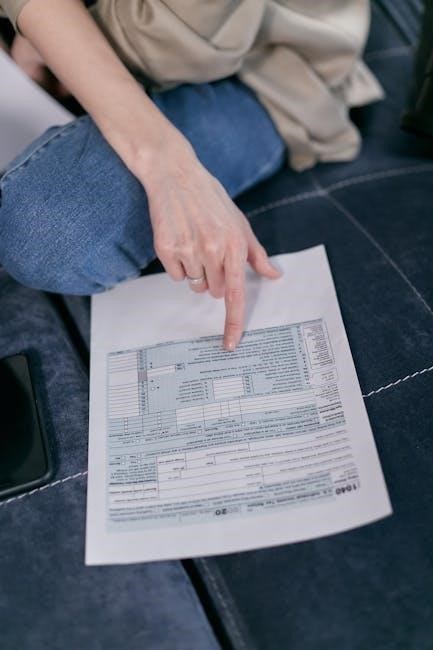Form 8915-F is a forever form used to report qualified disaster retirement plan distributions and repayments, including COVID-19-related distributions, ensuring accurate tax reporting and compliance with IRS guidelines;
Purpose of Form 8915-F
Form 8915-F is designed to report qualified disaster retirement plan distributions and repayments, including those related to COVID-19. It allows taxpayers to accurately account for distributions taken due to qualified disasters or the coronavirus pandemic. The form ensures proper tax reporting and compliance with IRS guidelines. It also enables taxpayers to claim relief for repayments made on such distributions. By using Form 8915-F, individuals can report the necessary details to the IRS, ensuring their tax obligations are met. This form is essential for those affected by disasters or COVID-19 who received early distributions from retirement plans.
History and Evolution of Form 8915-F
Form 8915-F was introduced to address the need for reporting qualified disaster retirement plan distributions and repayments. It replaced Form 8915-E beginning in 2021, expanding its scope to include COVID-19-related distributions. The form was designed to accommodate the unique challenges posed by the coronavirus pandemic and subsequent disasters. Over time, the IRS has updated the form to reflect changes in tax laws and regulations, ensuring it remains relevant and effective for taxpayers. Its evolution has been marked by periodic revisions, with the latest version incorporating feedback from taxpayers and tax professionals to improve clarity and usability. This form is now a permanent tool for disaster-related distributions.

Eligibility Criteria for Using Form 8915-F
Eligibility for Form 8915-F requires taxpayers to have received qualified disaster retirement plan distributions or COVID-19-related distributions, ensuring compliance with IRS guidelines for reporting and repayment.
Qualified Disaster Retirement Plan Distributions
Qualified disaster retirement plan distributions are withdrawals from retirement accounts made due to a federally declared disaster or COVID-19. These distributions are tax-favored and must meet specific IRS criteria. Recipients must have been adversely affected by the disaster or pandemic. The CARES Act expanded eligibility to include COVID-19 impacts, allowing taxpayers to report such distributions on Form 8915-F. These distributions are typically exempt from the 10% early withdrawal penalty, and taxes can be spread over three years. Proper documentation and adherence to IRS guidelines are essential to ensure compliance and avoid penalties.
Impact of COVID-19 on Eligibility
COVID-19 significantly expanded eligibility for retirement plan distributions under the CARES Act, allowing taxpayers affected by the pandemic to access retirement funds penalty-free. Form 8915-F was introduced to report these distributions, replacing Form 8915-E starting in 2021. Eligibility includes individuals diagnosed with COVID-19, those with a spouse or dependent diagnosed, or those experiencing adverse financial consequences due to the pandemic. The CARES Act permitted up to $100,000 in penalty-free withdrawals, with the option to repay amounts over three years. This provision provided financial relief and flexibility for individuals impacted by the pandemic, aligning with Form 8915-F’s purpose to streamline reporting for disaster-related distributions.

Key Features of Form 8915-F
Form 8915-F is designed to report qualified disaster distributions and repayments, offering streamlined compliance with IRS rules for disaster-related retirement plan transactions.
Reporting Distributions and Repayments
Form 8915-F requires detailed reporting of qualified disaster distributions and any repayments made. Taxpayers must report the amount of the distribution, the date it was received, and the retirement plan from which it was taken. Repayments are reported separately, and the form accounts for any reductions in taxable income due to repayments. It’s crucial to adhere to the specified deadlines for both reporting and repaying distributions to avoid penalties. The IRS provides guidelines to ensure accurate reporting, and consulting a tax professional can help navigate complex situations, especially those involving COVID-19-related distributions or other special circumstances.
Unique Aspects Compared to Other Forms
Form 8915-F is distinct as it specifically addresses qualified disaster distributions, offering relief for disaster-related financial hardships. Unlike other forms, it allows taxpayers to report distributions and repayments tied to federally declared disasters. It also provides flexibility in spreading taxable income over multiple years, reducing immediate tax burdens. Additionally, it incorporates COVID-19-related provisions, making it unique compared to earlier disaster relief forms. The form’s ability to handle both distributions and repayments in a single document streamlines the reporting process, distinguishing it from other IRS forms that may only address one aspect of retirement plan transactions.

Instructions for Completing Form 8915-F
Start by identifying your eligibility and gathering required documents, such as disaster-related distribution records. Carefully review each section to ensure accurate reporting of distributions and repayments. Follow IRS guidelines to avoid errors and meet deadlines. Utilize IRS resources for clarification and compliance with specific instructions tailored to Form 8915-F.
Step-by-Step Guide to Filling Out the Form
Begin by gathering necessary documents, including distribution records and repayment details. Enter personal information at the top of Form 8915-F. Report the distribution amount and date, using documentation from your retirement plan administrator. Calculate the taxable amount, considering any repayments made and applicable tax rates. Refer to IRS worksheets for calculations. Identify any disaster-related codes and apply special provisions, such as those under the CARES Act. Attach required documentation, like statements from your retirement plan. Ensure compliance with filing deadlines to avoid penalties. Double-check all entries for accuracy. Consult a tax professional if unsure about nuances. Keep a copy of the completed form and supporting documents for your records. Follow these steps meticulously to ensure compliance and avoid complications.
Important Notes from the IRS Instructions
The IRS emphasizes understanding eligibility criteria before filing Form 8915-F. Ensure distributions are from qualified disaster retirement plans. Repayment deadlines are critical; missing them may result in penalties. Taxpayers must report all distributions and repayments accurately. COVID-19-related distributions have specific rules under the CARES Act. Attach supporting documentation, such as plan statements, to avoid delays or audits. Use IRS resources, like Publication 590-B, for guidance. Taxpayers should consult a professional if unsure about repayment or reporting rules. Always verify the latest IRS updates, as form instructions may change. Compliance with these notes ensures accurate filing and avoids potential issues.

Qualified Disaster Retirement Plan Distributions
These distributions come from retirement plans like 401(k)s or IRAs due to qualified disaster events. They are tax-relieved under specific conditions, with a $100,000 limit. COVID-19 qualifies.
Definition and Examples
Qualified disaster retirement plan distributions are withdrawals from eligible retirement accounts due to a federally declared disaster. These distributions are exempt from the 10% early withdrawal penalty. Examples include distributions made due to Hurricanes Harvey or Irma, the California wildfires, or COVID-19 under the CARES Act. Eligible events must occur within specific timeframes, and the distribution amount cannot exceed $100,000. Recipients must also intend to use the funds for disaster-related expenses. These provisions aim to provide financial relief to individuals affected by disasters, allowing them to access retirement savings without penalties during crises.
Reporting Requirements
Reporting Requirements
Form 8915-F requires detailed reporting of qualified disaster distributions and repayments. Taxpayers must report the total distribution amount, the portion treated as income, and any repayments made. The form also requires documentation of the disaster event and proof of eligibility. Recipients must file Form 8915-F with their tax return (Form 1040) and attach it to Schedule 1. Accurate reporting ensures compliance with IRS rules and avoids penalties. Proper documentation, such as receipts for disaster-related expenses, should be maintained to support the reported amounts. Failure to meet reporting requirements may result in delayed processing or additional taxes owed.

Repayment Options and Implications
Repayment of qualified disaster distributions can be made within three years, reducing taxable income. Repayment impacts tax liabilities and retirement account balances, requiring careful planning.
How to Report Repayments
To report repayments, use Form 8915-F, Part II. Enter the year of the original distribution and the amount repaid in the appropriate columns. Repayments are reported in the year they are made. Ensure accurate reporting to avoid discrepancies. For example, if repaying a 2020 distribution in 2023, report it in the 2023 section. Include details like the retirement plan type and account balance. Attach supporting documents if required. Repayment reporting impacts taxable income and may reduce prior taxes owed. Follow IRS instructions carefully to ensure compliance and avoid penalties.
Tax Implications of Repayments
Repaying distributions reported on Form 8915-F can reduce taxable income in the year of repayment. Repayments are treated as rollovers, allowing taxpayers to avoid paying taxes on the amounts repaid. This can lower the overall tax liability or increase the refund for the year. Additionally, repayments may eliminate the 10% early withdrawal penalty if certain conditions are met. Properly reporting repayments ensures accurate tax calculation and avoids penalties. The IRS allows repayment to the same or a different retirement account, providing flexibility. Taxpayers should consult IRS guidelines to ensure compliance and maximize tax benefits from repayments.

CARES Act and Form 8915-F
The CARES Act introduced COVID-19-related retirement plan distributions, which can be reported using Form 8915-F. It provides tax relief and repayment flexibility for eligible individuals impacted by the pandemic.
COVID-19 Related Distributions
The CARES Act allowed qualified individuals to take COVID-19-related retirement plan distributions of up to $100,000 in 2020. These distributions were exempt from the 10% early withdrawal penalty and could be repaid within three years. Form 8915-F is used to report such distributions and any repayments. Eligible individuals included those diagnosed with COVID-19, whose spouse or dependent was diagnosed, or who experienced adverse financial consequences due to the pandemic, such as quarantine, reduced work hours, or closed businesses. The IRS provided relief by allowing taxpayers to spread income recognition over three years or report it in the year of distribution, offering flexibility.
Special Provisions for 2020 Distributions
For 2020, the CARES Act introduced special provisions allowing qualified individuals to take coronavirus-related distributions (CRDs) of up to $100,000 from retirement accounts. These distributions were exempt from the 10% early withdrawal penalty and could be repaid within three years. Taxpayers could also choose to spread the taxable income over three years or report it entirely in 2020. Form 8915-F was updated to reflect these provisions, enabling taxpayers to report CRDs and any repayments made. The IRS provided relief by waiving the 20% withholding requirement for CRDs, offering flexibility to those affected by the pandemic.
IRS Guidelines and Updates
The IRS regularly updates Form 8915-F to reflect legislative changes and tax law modifications. Taxpayers must use the most recent version and follow specific instructions provided.
Latest Revisions to Form 8915-F
The IRS has introduced updates to Form 8915-F to align with recent tax law changes and improve clarity. The 2023 revision includes new fields for reporting repayment amounts and expanded instructions for COVID-19-related distributions. Additional guidance addresses qualified disaster distributions, ensuring compliance with the CARES Act provisions. The IRS has also streamlined the form to reduce complexity, making it easier for taxpayers to report distributions and repayments accurately. These updates reflect the IRS’s commitment to adapting tax forms to evolving legislative requirements and taxpayer needs.
IRS Resources for Taxpayers
The IRS provides several resources to help taxpayers understand and complete Form 8915-F accurately. The official IRS website offers detailed instructions, FAQs, and related publications. Taxpayers can access Form 8915-F and its instructions directly from the IRS website. Additionally, the IRS publishes guides like Publication 590-B, which covers distributions from individual retirement arrangements. The IRS also offers phone support for specific questions and operates Taxpayer Assistance Centers (TACs) for in-person help. Staying updated with IRS resources ensures taxpayers comply with the latest regulations and accurately report their distributions and repayments.

Comparison with Form 8915-E
Form 8915-F replaces Form 8915-E, expanding its scope to cover more disaster-related distributions. It offers broader eligibility and additional reporting fields for repayments and tax implications.
Differences in Scope and Use
Form 8915-F differs from Form 8915-E in its expanded scope, covering a broader range of disaster-related retirement plan distributions. While Form 8915-E was limited to specific disaster events, Form 8915-F is applicable to a wider variety of federally declared disasters. Additionally, Form 8915-F introduces new fields for reporting repayments of coronavirus-related distributions, aligning with CARES Act provisions. It also provides clearer instructions for calculating taxable amounts and reporting distributions from multiple plans. This enhanced flexibility makes Form 8915-F more comprehensive, addressing a broader audience and simplifying compliance for taxpayers affected by disasters.
Transition from Form 8915-E to 8915-F
The IRS introduced Form 8915-F to replace Form 8915-E, expanding its application to more disaster scenarios. Taxpayers who previously used Form 8915-E for specific disasters now transition to Form 8915-F for broader eligibility. The new form consolidates reporting requirements and aligns with updated disaster relief provisions. Key changes include expanded distribution eligibility and simplified repayment tracking. Taxpayers should ensure they use the correct form based on the disaster year and type. The IRS provides transitional guidance to help taxpayers navigate the shift seamlessly, ensuring compliance with updated regulations.
Common Mistakes to Avoid
- Mistakes include missing repayment deadlines and misreporting distribution amounts.
- Ensure accurate documentation and verify calculations to prevent errors.
Errors in Reporting Distributions
Common errors include reporting incorrect distribution amounts, failing to indicate the correct taxable year, and misusing distribution codes. Ensure accurate entry of qualified disaster distributions, as improper reporting can delay processing or trigger IRS scrutiny. Verify amounts against Form 1099-R and distinguish between qualified and non-qualified distributions. Additionally, ensure compliance with repayment rules and deadlines to avoid penalties. Always cross-reference IRS guidelines to confirm eligibility and proper reporting procedures. Utilize IRS resources, such as instructions and publications, to minimize errors and ensure compliance with Form 8915-F requirements.
Missed Deadlines and Penalties
Failing to meet deadlines for filing Form 8915-F or repaying distributions can result in penalties and additional taxes. Missing the repayment deadline may lead to the loss of favorable tax treatment, requiring the inclusion of the distribution in taxable income. Late filings can trigger IRS penalties and interest on unpaid taxes. Ensure timely submission and repayment to avoid these consequences. The IRS may waive penalties for reasonable cause, but documentation is required. Consult IRS guidelines or a tax professional to address missed deadlines and mitigate potential penalties effectively. Timely compliance is crucial to avoid unnecessary financial and legal complications.

Troubleshooting and FAQs
Troubleshooting common issues with Form 8915-F involves addressing errors in reporting or repayment. FAQs often cover eligibility, deadlines, and repayment options. Visit the IRS website for detailed guidance.
Frequently Asked Questions
- What is Form 8915-F used for? It reports qualified disaster retirement plan distributions and repayments.
- Who is eligible to file Form 8915-F? Individuals affected by qualified disasters or COVID-19.
- What is the deadline for filing? Generally, the same as your tax return deadline.
- Do I need to attach documentation? Yes, proof of distribution and repayment may be required.
- Can I repay a distribution? Yes, repayments may reduce taxable income.
- How does the CARES Act affect this form? It allows COVID-19-related distributions.
- Where can I find more help? Visit the IRS website or consult a tax professional.
Resolving Discrepancies in Reporting
If discrepancies arise when filing Form 8915-F, review your entries for accuracy. Ensure distributions and repayments align with records from your retirement plan. If the IRS identifies issues, respond promptly to their notices; Correct errors by filing an amended return or providing additional documentation. Keep detailed records of all transactions, as audits may require proof of eligibility. For unresolved issues, contact the IRS or consult a tax professional. Timely resolution prevents penalties and ensures compliance with tax obligations. Accuracy is crucial to avoid delays or further complications.

Future of Form 8915-F
The IRS plans to update Form 8915-F annually to reflect changing tax laws and disaster relief provisions; Future updates will streamline reporting processes and expand eligibility criteria.
Permanent Status as a “Forever Form”
Form 8915-F is designated as a “Forever Form,” meaning it will be updated annually to accommodate changes in tax laws and disaster relief provisions. This designation ensures the form remains relevant and adaptable to future disasters and legislative updates. The IRS will revise it to include new qualified disasters and modify reporting requirements as needed; Taxpayers can expect consistent use of this form for disaster-related distributions without needing new forms for each event. Its permanent status streamlines reporting processes and provides clarity for those affected by disasters.Annual updates will reflect evolving tax policies and disaster relief needs.
Expected Updates and Changes
Form 8915-F will likely undergo updates to reflect new disaster designations and evolving tax regulations. The IRS may expand eligibility criteria or introduce additional reporting fields to capture more detailed information. Future updates could also clarify repayment options and extend relief provisions for specific disasters. Taxpayers should anticipate annual revisions to align with legislative changes, such as new disaster declarations or amendments to retirement plan distribution rules. The IRS will publish updated instructions and forms, ensuring compliance with current tax laws. Staying informed through official IRS resources will be crucial for accurate filing and adherence to new requirements.
Form 8915-F is crucial for accurately reporting disaster-related retirement distributions. Proper compliance ensures timely processing and avoids penalties. Always refer to IRS guidelines for the latest updates.
Final Thoughts on Form 8915-F
Form 8915-F is a vital tool for taxpayers affected by qualified disasters, enabling them to report retirement plan distributions and repayments accurately. It simplifies compliance with IRS rules, ensuring proper tax treatment and avoiding penalties. The form’s clarity and structure make it user-friendly, though careful attention to instructions is essential. Taxpayers should always verify eligibility criteria and consult IRS resources for updates. By following guidelines and seeking professional advice if needed, individuals can navigate the process smoothly, ensuring accurate reporting and maximizing tax relief. Proper use of Form 8915-F is key to maintaining compliance and financial stability.
Importance of Compliance
Adhering to IRS guidelines when using Form 8915-F is crucial to avoid penalties and ensure accurate tax reporting. Compliance guarantees that distributions and repayments are properly documented, preventing audits and disputes. Failure to comply may result in delayed refunds, additional taxes, or fines. Accurate reporting also upholds the integrity of tax relief programs, ensuring fair treatment for all taxpayers. Consulting IRS resources or tax professionals can help maintain compliance, reducing errors and stress. Proper compliance not only safeguards individual financial interests but also supports the broader tax system’s effectiveness and fairness.



